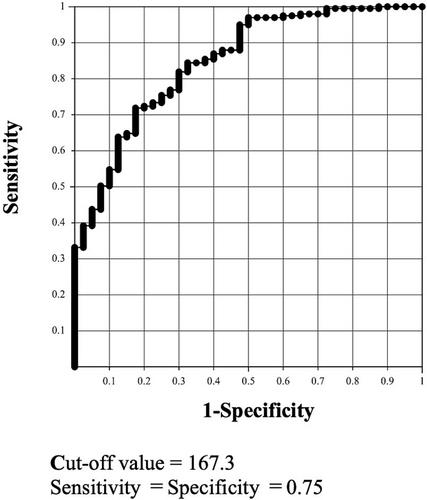Relationship between sacral-abdominal wall distance and grip strength in postmenopausal osteoporotic patients
Abstract
Background
An increase in waist circumference (WC) is a factor in lifestyle-related diseases. The rectus abdominis muscle is a skeletal muscle that attaches to the pelvis from the xiphoid process and is thought to be affected by kyphosis deformity and posterior pelvic tilt. The purpose of this study is to examine differences between sacral-abdominal wall distance (SAD) and WC and to determine whether they are associated with fall risk, frailty, markers of sarcopenia (grip strength and lean body mass), and spinal alignment. A secondary objective is to examine these differences by stratification by grip strength.
Methods
This retrospective study included 239 women aged 65 years or older (mean age 76.5 ± 6.7 years) attending an outpatient osteoporosis clinic. Bone mineral density and skeletal body composition (muscle mass index and trunk lean mass) were measured using dual-energy X-ray absorptiometry. SAD, pelvic tilt, and sagittal longitudinal axis were measured from simple X-ray images of the spine sides. WC, grip strength, frailty, and fall risk score were investigated. Statistics were performed using Stat Flex, with two-sided P < 0.05 being significantly different.
Results
WC was correlated with SAD (R = 0.68, P < 0.001). The SAD cut-off value for a WC of 90 cm was 167 mm. The relationship between grip strength, SAD, and WC, weaker grip strength was associated with greater SAD; however, no significant difference was noted in WC. WC was not correlated with pelvic alignment but was correlated with body mass index (P < 0.01). Meanwhile, SAD was correlated with body mass index, pelvic tilt, sagittal longitudinal axis (P < 0.01), spinal alignment, and WC. Logistic regression analysis was performed with a grip strength of less than 18 kg as the objective variable. We found that the conditions for a grip strength of less than 18 kg were older age (P < 0.001), increased SAD (P = 0.02), and decreased trunk lean body mass. There was a decrease in grip strength (P < 0.05) and an increase in frailty (P < 0.05) and falls (P < 0.01) score in patients with SAD of 167 mm or greater.
Conclusions
SAD and WC were found to be correlated; SAD was associated with body weight, posterior pelvic tilt, and anterior spinal tilt deformity, while WC was related to body weight. Increased SAD was found to be linked with decreased grip strength and increased risk of falls. This study was the first to examine a new measurement, SAD, for its utility in assessing grip strength, spinal alignment, frailty, and fall risk.


 求助内容:
求助内容: 应助结果提醒方式:
应助结果提醒方式:


